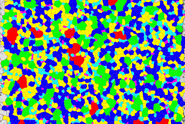Introduction
Steel is one of the most widely used materials in the world [1]. It is used in a large number of industrial applications, like manufacturing of vehicles, machines, pipelines, and cable towers as well as constructing ships and buildings. Steel quality is critical for these applications, and the rating of non-metallic inclusions (NMIs) in steel is exploited to determine their influence on the quality [2-4]. Fast, precise, and flexible NMI rating solutions which deliver reliable and consistent results offer significant advantages for steel producers and manufacturers of components and parts made with steel. The basic working principles of an automated solution and its advantages for rating steel inclusions are described in this article.
How an Automated NMI Rating Solutions Works
The rating of NMIs to determine steel quality in an efficient and cost-effective way for steel production and industry manufacturing can be achieved, overcoming the challenges arising with manual rating solutions [5], using an automated rating solution.
An automated solution consists of an optical microscope with a motorized stage and objective nosepiece operated with a sophisticated software. It enables a fully automated inclusion rating over the whole steel sample. The typical workflow consists of [2]:
- Definition of the sample and scan area.
- Definition of 5 or 9 focus points in the scan area for data acquisition.
Automatic analysis of the entire sample without the need for users to be present during
Advantages of an Automated NMI Rating Solution
An automated solution offers several advantages when compared to manual NMI rating:
- With careful sample preparation, automated rating enables a fast and reliable analysis of multiple, whole samples
- The automated solution delivers consistent results even if several users are involved or if the system is left unattended during operation
- Advanced review capabilities enable discernment between different types of inclusions or between inclusions and artifacts
- The results obtained are unbiased (independent of the user) and NMI rating is compliant with international, regional, and organizational standards [2,6]
- The software makes all chosen standards available for comparison of the results during a single scan. Inclusion analysis of the same sample can also be done using multiple standards.
An example of an automated NMI rating solution [2] is the Steel Quality Solution Suite from Leica Microsystems utilizing the LAS X Steel Expert software.
References
- J. DeRose, D. Barbero, Reasons Why There is Growing Need for Fast and Reliable Steel Quality Rating Solutions, Science Lab (2020) Leica Microsystems. D. Diez, J. DeRose, T. Locherer, Rate the Quality of Your Steel: Free Webinar and Report: Overview of standard analysis methods and practical solutions for evaluating steel inclusions, Science Lab (2020) Leica Microsystems.
- A. Schué, Steel - It All Depends on What's Really Inside: New European Standard in Steel Industry, Science Lab (2009) Leica Microsystems.
- N. Ecke, Analyzing non-metallic inclusions in steel, Science Lab (2020) Leica Microsystems.
- J. DeRose, D. Barbero, Challenges Faced When Manually Rating Non-Metallic Inclusions (NMIs) to Determine Steel Quality, Science Lab (2020) Leica Microsystems.
- J. DeRose, D. Barbero, T. Locherer, Top Issues Related to Standards for Rating Non-Metallic Inclusions in Steel, Science Lab (2020) Leica Microsystems.

![[Translate to chinese:] Definition of the sample scan area in the LAS X Steel Expert software.](/fileadmin/_processed_/4/9/csm_Definition_of_the_sample_scan_area_in_the_LAS_X_Steel_Expert_software_18a0bff6f4.png)
![[Translate to chinese:] DMi8 A Inverted Microscope - Professional Configuration](/fileadmin/_processed_/2/5/csm_Inverted_-_NMIR_Professional_Solution_Suite_-_DMi8_A_6837d067a4.jpg)



